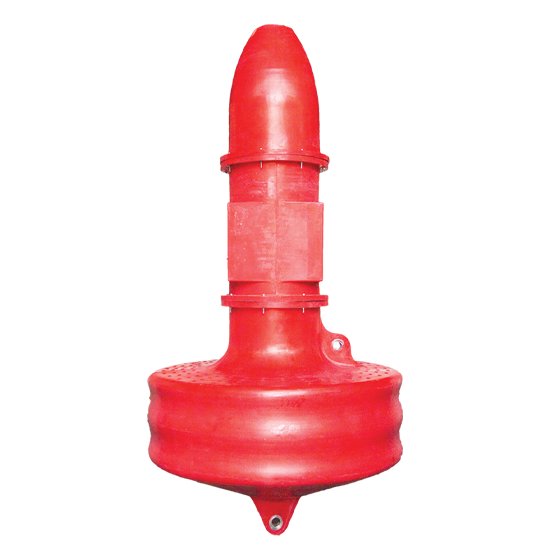floating buoy
brand : TPC Marine
The floating buoys produced by Tabriztan Plastic Complex are made from high-grade polyethylene materials. All metal parts used inside and outside these buoys are made of 316 stainless steel, which is suitable for marine environments. These products are equipped with mounting points for lights, batteries, and solar panels, and are designed to be both safety and radar types. The design of Tabriztan Plastic Complex buoys ensures stable balance and buoyancy in the water. They are available in yellow, red, and green colors. Upon customer request, they can also be manufactured in other colors. The raw materials used in these buoys are the same as those used in the company’s tanks, and the colors applied are highly resistant to marine and oceanic environmental conditions. For detailed dimensions and specifications, please refer to the table below. For consultation with our sales expert, please contact +98 991 206 9412.
Tabarestan Polyethylene Buoy
The floating buoys produced by Tabarestan Plastic Complex are made from premium-grade polyethylene materials.
All metallic components used inside and outside the buoys are made of 316 stainless steel, which is ideally suited for marine environments.
These products are equipped with mounting locations for lights, batteries, and solar panels, and are designed as safety and radar-type buoys.
The design of Tabarestan Plastic Complex buoys ensures stable balance and upright positioning in the water.
They are available in yellow, red, and green, and can also be manufactured in other colors upon customer request.
The raw materials used in these buoys are the same as those used in the company’s storage tanks, and the colors are highly resistant to marine and oceanic environmental conditions.
About Buoys
A buoy is a floating object typically made from durable materials such as plastic, metal, or foam, designed to remain afloat on the water’s surface.
It should be noted that polyethylene buoys are preferable to metal ones.
Polyethylene is lighter than metal, making transportation and installation easier.
Additionally, Tabarestan floating buoys are filled with polyurethane foam, which further reduces weight and enhances buoyancy.
Since polyethylene is waterproof and highly resistant to moisture, polyethylene buoys are ideal for marine applications.
Physical Specifications
| Immersion Rate (kg/cm) | Maximum Draft after Loading (mm) | Maximum Load (kg) | Buoyancy Volume (liter) | Reverse Buoyancy Volume | Waterline (mm) | Nominal Buoyancy Height (mm) | Overall Volume with Mast (Liter) | Freeboard Height (mm) | Available Marine Standard Colors | Product Name | Product Code |
| 54 | 990 | 1475 | 900 | 4800 | 690 | 780 | 5700 | 3850 |
Green - Red - Yellow |
Buoy 2600 | 2713004 |
| 39 | 960 | 1050 | 630 | 3670 | 690 | 780 | 4300 | 3200 |
Green - Red - Yellow |
Buoy 2200 | 2713007 |
| 18.2 | 605 | 280 | 200 | 930 | 450 | 460 | 1130 | 1680 |
Green - Red - Yellow |
Buoy 1500 | 2713002 |
| 3 | 470 | 60 | 24.5 | 135.5 | 265 | 280 | 160 | 1105 |
Green - Red - Yellow |
Buoy 700 | 2713301 |
Features of Tabarestan Buoys
-
Made of polyethylene
-
Produced from UV-resistant raw materials
-
316 stainless steel internal reinforcement
-
Filled with polyurethane foam
-
Available in green, red, and yellow
-
Custom colors available upon request
-
Fitted to support light, battery, and solar panel installation
-
Colors resistant to harsh oceanic environments
Applications of Buoys
One of the main purposes of floating buoys is to aid navigation.
In marine environments, buoys act as markers that guide ships safely through waterways.
They indicate navigation channels, shallow areas, hazardous zones, and other important information that helps vessels navigate accurately.
By providing clear visual warnings, buoys play a vital role in ensuring maritime safety.
However, navigation assistance is not the only application of buoys.
In scientific research, specially equipped buoys with sensors and instruments collect valuable data on weather patterns, ocean currents, water temperature, salinity levels, and more.
These data help scientists study climate change, monitor marine ecosystems, and improve weather forecasting models.
Furthermore, buoys play an important role in marine communications.
Some are equipped with radio beacons or satellite transmitters that send signals to ships, providing essential information about weather conditions and marine traffic.
This communication enables sailors to make informed decisions, ensuring their safety and security at sea.
In the marine energy industry, buoys are used to mark the positions of underwater structures, such as oil platforms or subsea cables.
They serve as warning markers for vessels, helping to prevent accidental damage to these installations.
Buoys are also widely used in the fishing industry to mark the locations of nets or traps, assisting fishermen in efficiently locating and managing their equipment.
It is worth noting that to ensure their proper functionality, buoys must be regularly maintained and serviced.
Such maintenance guarantees smooth navigation and ensures the accuracy and reliability of collected data.
Additionally, buoys may need to be relocated periodically due to changes in water depth or current flow.
Buoy Pricing
The price of a floating buoy depends on several factors, with build quality and type of equipment used being the most significant.
Other factors influencing the cost include the price of raw materials, manufacturing quality, technological complexity, and the brand reputation of the manufacturer.
Purchasing Buoys
Tabarestan Plastic Complex is the largest manufacturer of polyethylene tanks in Iran and a well-known, trusted name in the production of polyethylene marine products.
For this reason, it is an excellent choice for purchasing floating buoys.
If you wish to buy a buoy, please visit the Sales Representatives section on our website, where you can find the nearest distributor, check current prices, and proceed with your purchase.


 فارسی
فارسی English
English عربي
عربي کوردی
کوردی







